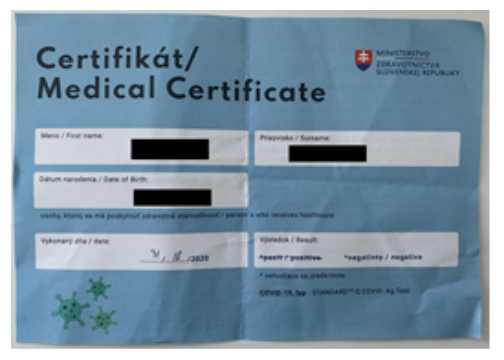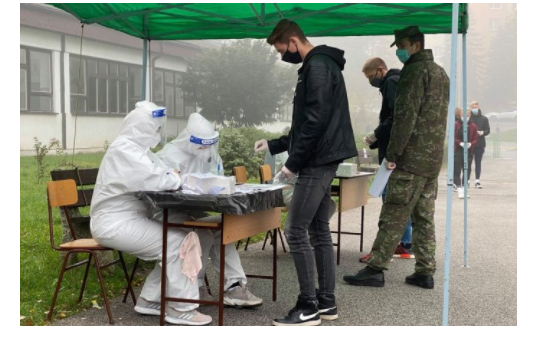Download the full report on Slovakia’s population testing
As the UK enters into its second national lockdown, a possible light at the end of the long COVID tunnel emerged from a small country in Central Europe. Last weekend, Slovakia tested 3.6 million people for coronavirus – 97% of the eligible population of people aged 10-65.
The goal was to identify as many positive cases as possible, and take them out of circulation – with the idea being that this could help the country avoid having to enter lockdown. This idea could help to achieve the compromise of saving lives and livelihoods at the same time.
The mass testing has been an enormous success – it identified 38,000 new cases in two days, 15 times more than the Slovakian testing system identifies on an average day. BIT visited Slovakia to see how they did it, and what lessons this holds for to the UK.
1. A mix of old and new technology is the way forward
To test so many people in so short a time, Slovakia used ‘lateral flow’ tests, a new coronavirus testing technology which can return results in about 15 minutes, without the need to send the test kits off to a laboratory. But, this cutting-edge technology was underpinned by a paper-based system for registering people’s test results. People who tested negative were provided with a paper certificate and released from a strict curfew. People who tested positive had to self-isolate, along with their households, for 10 days.
This balance of old and new technologies helped the government quickly deploy the operation while avoiding any major technical glitches.
2. Enormous logistical support is needed for testing at scale
From inception to launch, the mass testing operation took only 17 days. This rapid deployment was only possible because of the enormous manpower involved – 40,000 personnel, including 15,000 healthcare workers, 8,000 troops and volunteers.
To do the actual testing, Slovakia set up almost 5,000 sites across the country – similar to the number of sites it sets up during national elections. A typical site had multiple testing spots, and each spot aimed to conduct about 35 tests an hour, or up to 1,000 across the two days. Each spot was manned by 6-8 people: 1 soldier (commanding officer), 1 police officer (security), 2 volunteers (admin) and 2-4 healthcare professionals, including medical students (test administration).

On arrival, a person registered using their national photo ID, then cleared her nose and throat, had her swab, and waited for 15-20 min for the results – and certificate. If other countries were to replicate this, they would need about 1,000 locations and 8,000 staff per 1m of the population.
3. Public buy-in is best achieved with a carrot and stick approach
The government was very motivated to deploy mass testing in response to Slovakia’s recent surge in coronavirus cases (currently at 458 cases per 1,000,000) and to avoid the scenario seen in its neighbour Czech Republic (1053 cases per 1,000,000), now the second worst-hit EU country.
In response to this surge, Slovakia introduced a strict curfew in late October, with people only being able to leave home for essential shopping and work. This was the ‘stick’. The ‘carrot’ was the government’s subsequent offer of mass testing as a way for people to escape this curfew; people who tested negative at the weekend would be allowed to resume going out to work and shops and restaurants (outdoor service only), in compliance with other guidelines.
Those without certificates showing a negative test result would have to continue living under the curfew until the next round of testing this weekend or till mid-November. Meanwhile, positive cases would be offered state-provided accommodation (if needed) and sick pay.

Example certificate showing a person’s coronavirus test result
Lessons for the UK
As a Slovakian living abroad for the last 10 years, I’m proud and flabbergasted by this achievement. I went abroad to learn about what works and how to use evidence-based policy, only to find that that world has more to learn from Slovakia than the other way round (at least in this particular case). In a way, this achievement fits in with the national mythology of Slovaks waking up to fight for survival, as captured in the national anthem, as well (There is lightning over the Tatras, Thunders loudly sound, Let us stop them, brothers, After all they will disappear, The Slovaks will revive).
Although China pioneered the mass-testing of whole city populations (in Wuhan, Qingdao, and Kashgar), Slovakia is the first country in Europe to deploy this for the entire population.
As the UK government begins to deploy mass testing in Liverpool, it should bear in mind the three key lessons of Slovakia’s success:
- Use cutting-edge technology for the tests, but pen and paper for the back-end organisation.
- Plan for a huge logistical commitment – mass testing invariably requires tens of thousands of staff working long hours.
- Give the public a strong incentive to get tested – for example, by allowing them to get back some freedoms if they test negative.
By quickly identifying the positive cases who really do need to self-isolate, and limiting their risk of spreading the virus to others, mass testing offers a clear way for the country to safely exit lockdown.





